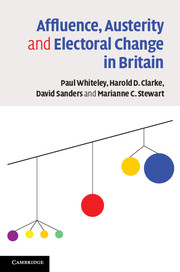Book contents
- Frontmatter
- Contents
- List of Figures
- List of Tables
- Acknowledgments
- 1 The politics of affluence and austerity
- 2 Tony's politics
- 3 Gordon's politics
- 4 ‘I agree with Nick’
- 5 Making political choices
- 6 Bearish Britain
- 7 Choosing how to choose
- 8 Performance politics and subjective well-being
- 9 Valence politics, austerity policies and electoral prospects
- Appendix A Design of the 2010 British election study
- Appendix B Measurement
- Notes
- Bibliography
- Index
5 - Making political choices
2010
Published online by Cambridge University Press: 05 June 2014
- Frontmatter
- Contents
- List of Figures
- List of Tables
- Acknowledgments
- 1 The politics of affluence and austerity
- 2 Tony's politics
- 3 Gordon's politics
- 4 ‘I agree with Nick’
- 5 Making political choices
- 6 Bearish Britain
- 7 Choosing how to choose
- 8 Performance politics and subjective well-being
- 9 Valence politics, austerity policies and electoral prospects
- Appendix A Design of the 2010 British election study
- Appendix B Measurement
- Notes
- Bibliography
- Index
Summary
Understanding party choice is a central concern for students of voting and elections. In previous chapters of this book and in earlier studies (Clarke et al., 2004b; 2009b) we have estimated various models of voting with the aim of determining which one provides the best account of the electoral choices people make. These statistical comparisons favour a composite model since no single theoretical account captures all of the factors which influence party choice. However, it bears emphasis that the valence model exhibits the strongest explanatory power. The valence politics model proved itself in the 2001 and 2005 general elections in Britain as the best single model for explaining why people vote as they do (Clarke et al., 2004b, 2009b). The valence model also consistently performs very well in analyses of voting in national elections in Canada and the United States (Clarke et al., 2009a; Clarke et al., 2012) and there is evidence to suggest that it works well in other mature and emerging democracies (Clarke and Whitten, 2013; Ho et al., 2013; Lewis-Beck et al., 2012). In all these cases, statistical analyses indicate that the valence model dominates rival models of voting behaviour, although it does not formally encompass them in the sense of completely accounting for competitors’ contributions to explaining why individuals vote as they do (Charemza and Deadman, 1997). As a result, a composite specification generally provides marginally greater explanatory purchase than a pure valence model.
- Type
- Chapter
- Information
- Affluence, Austerity and Electoral Change in Britain , pp. 129 - 167Publisher: Cambridge University PressPrint publication year: 2013



